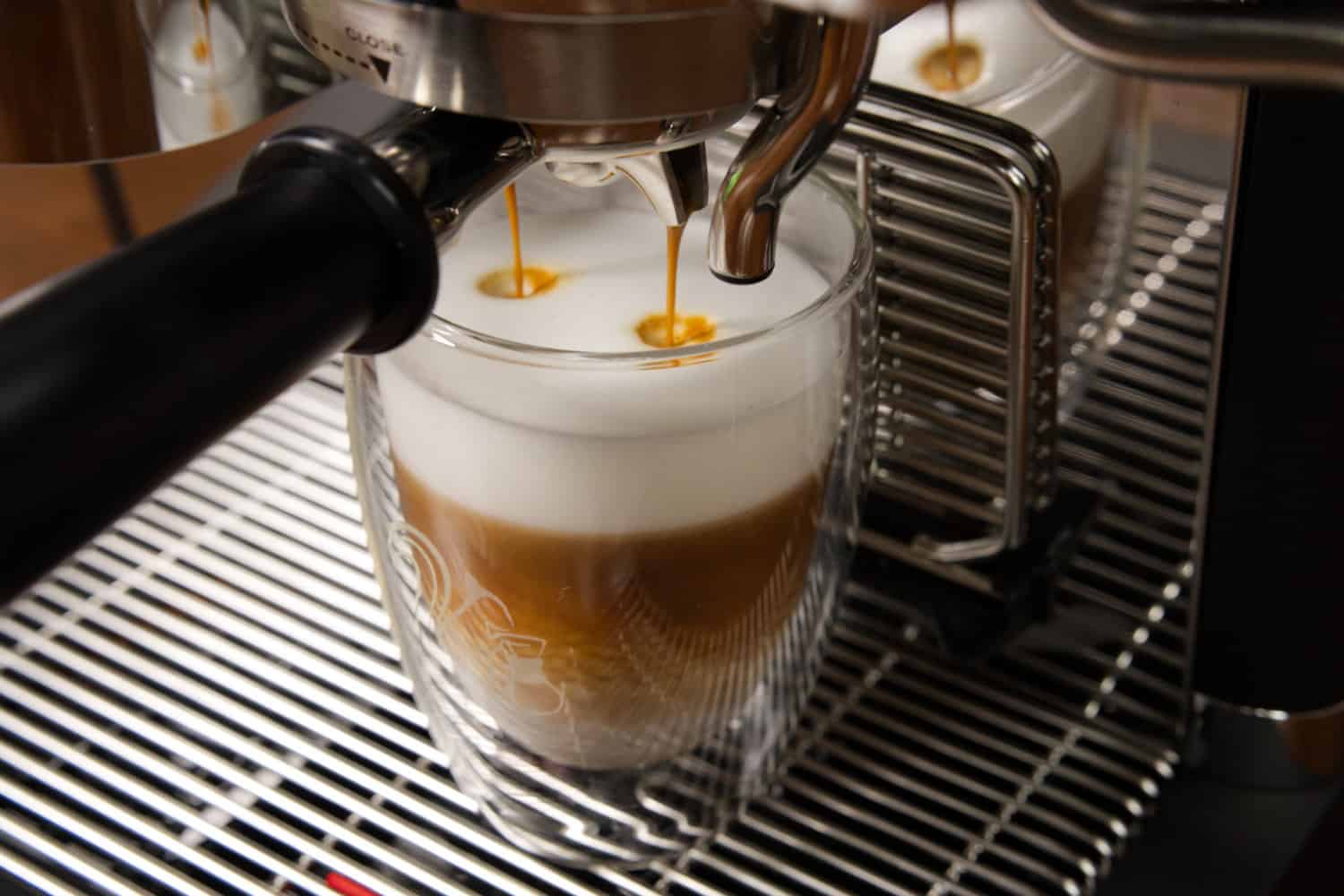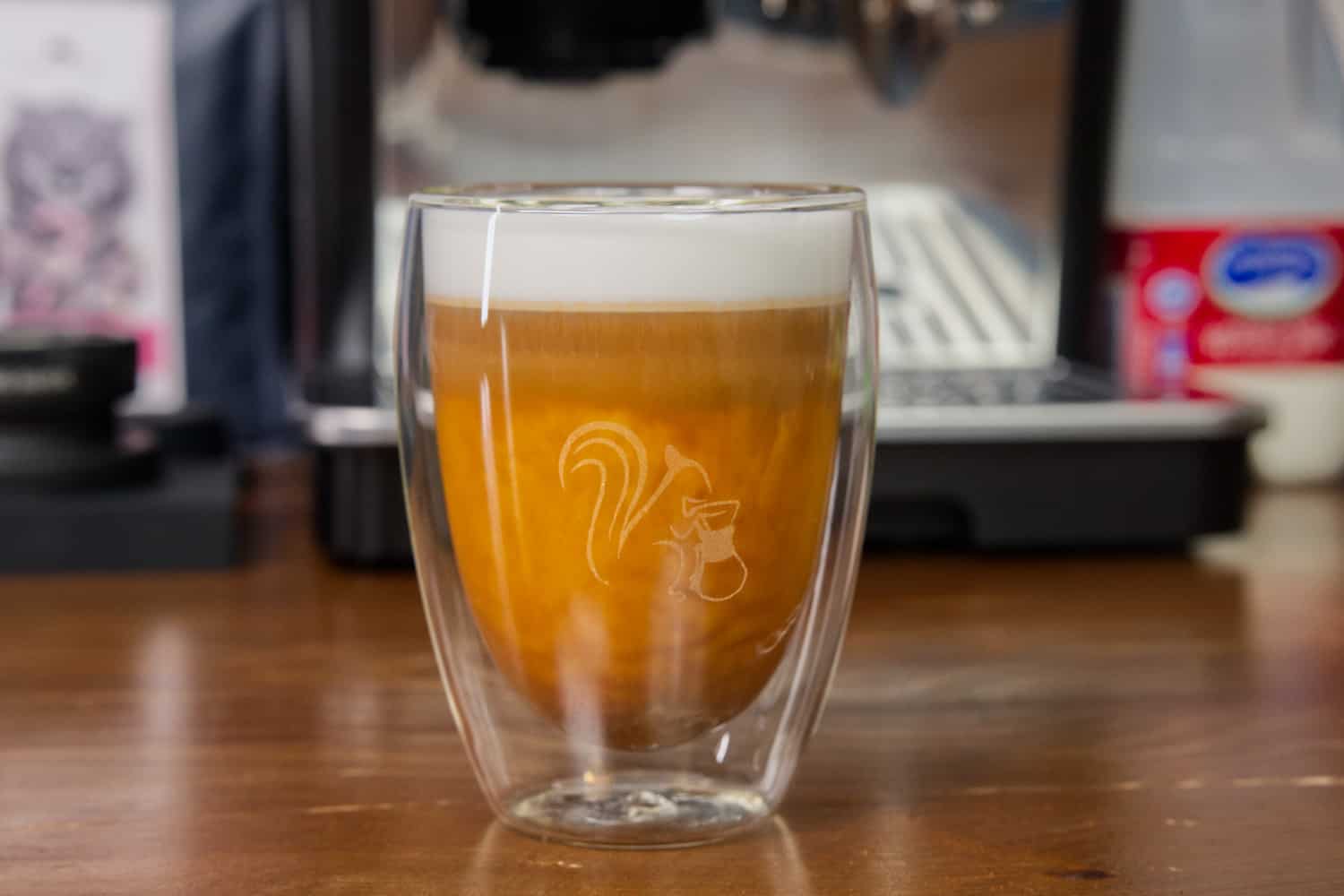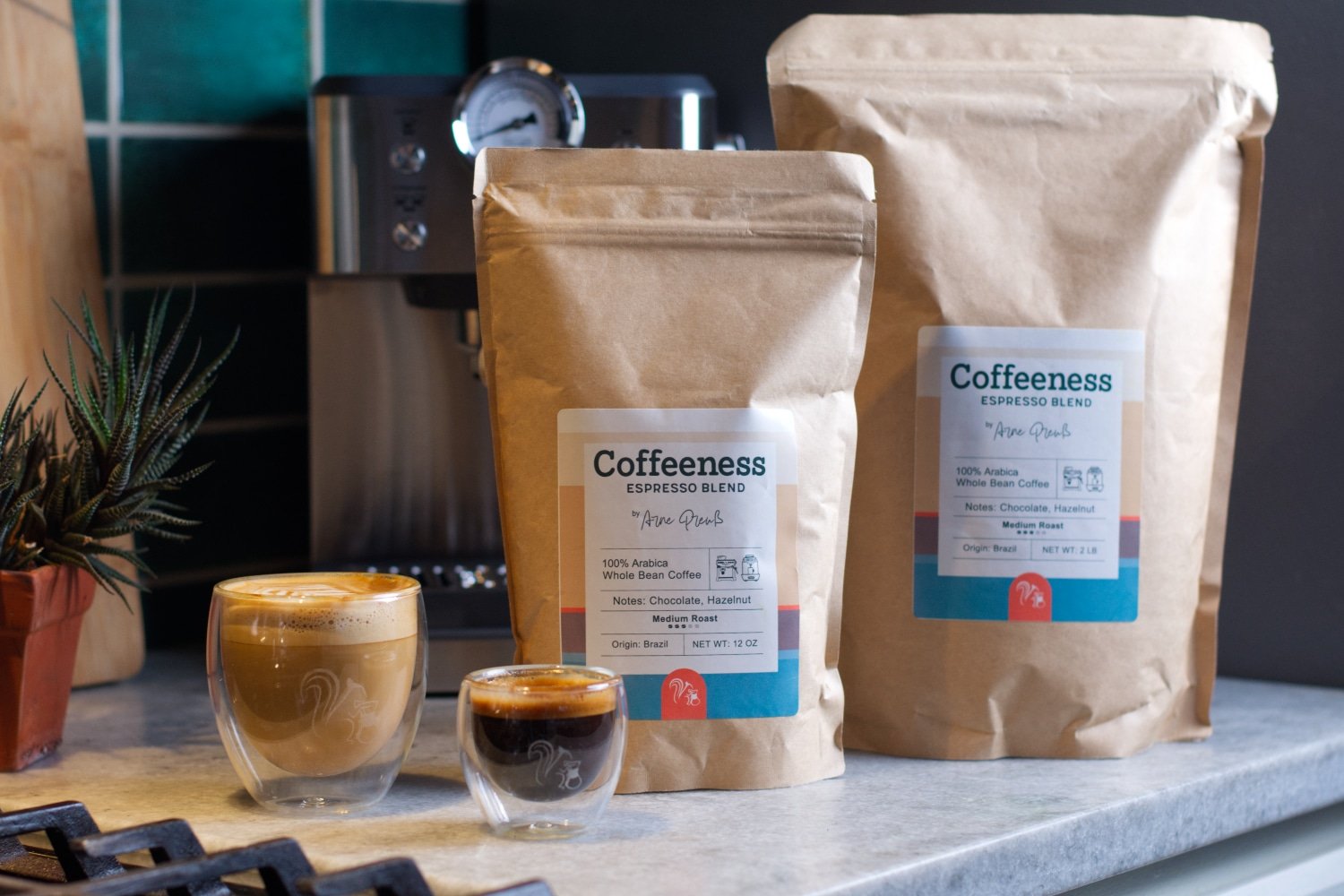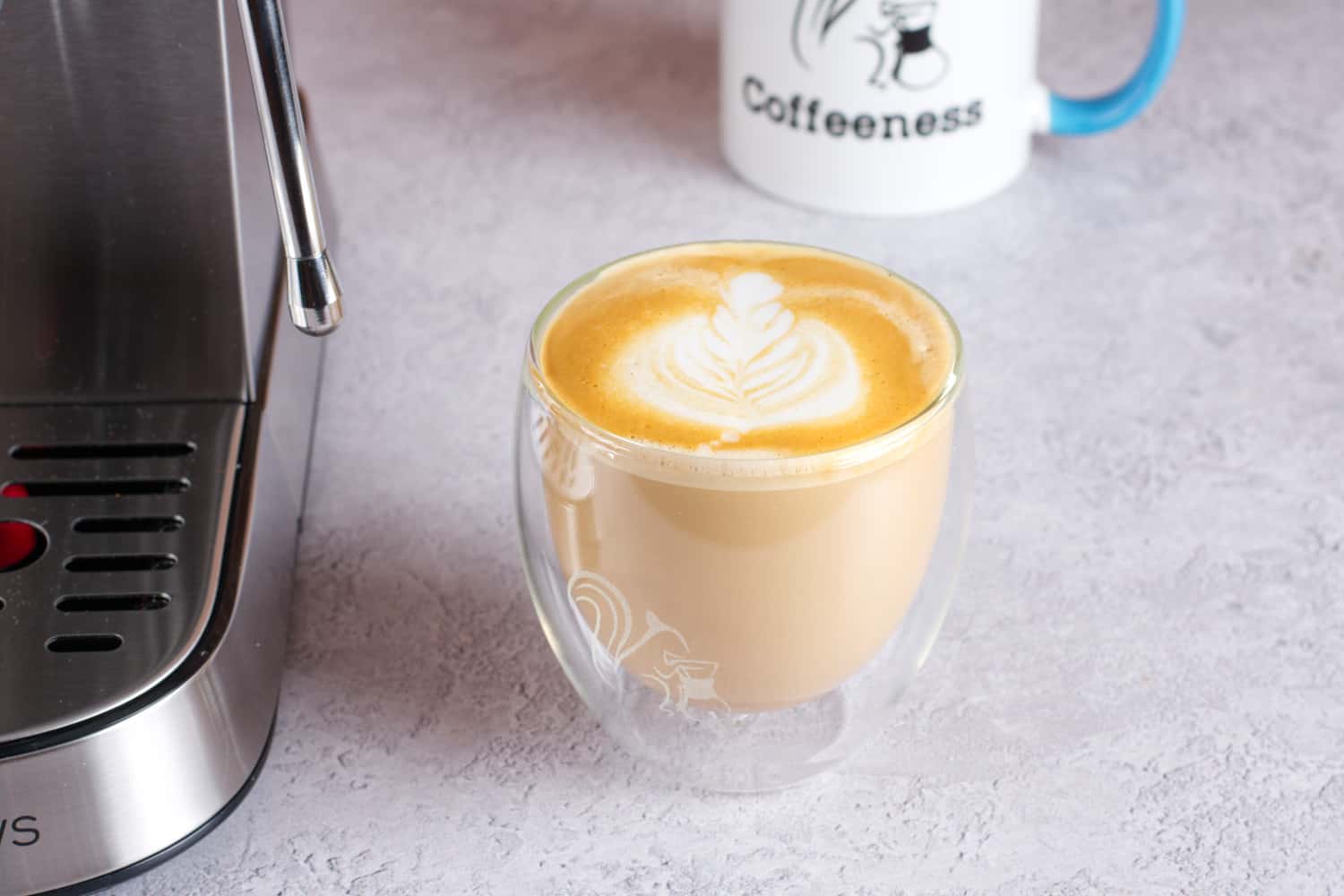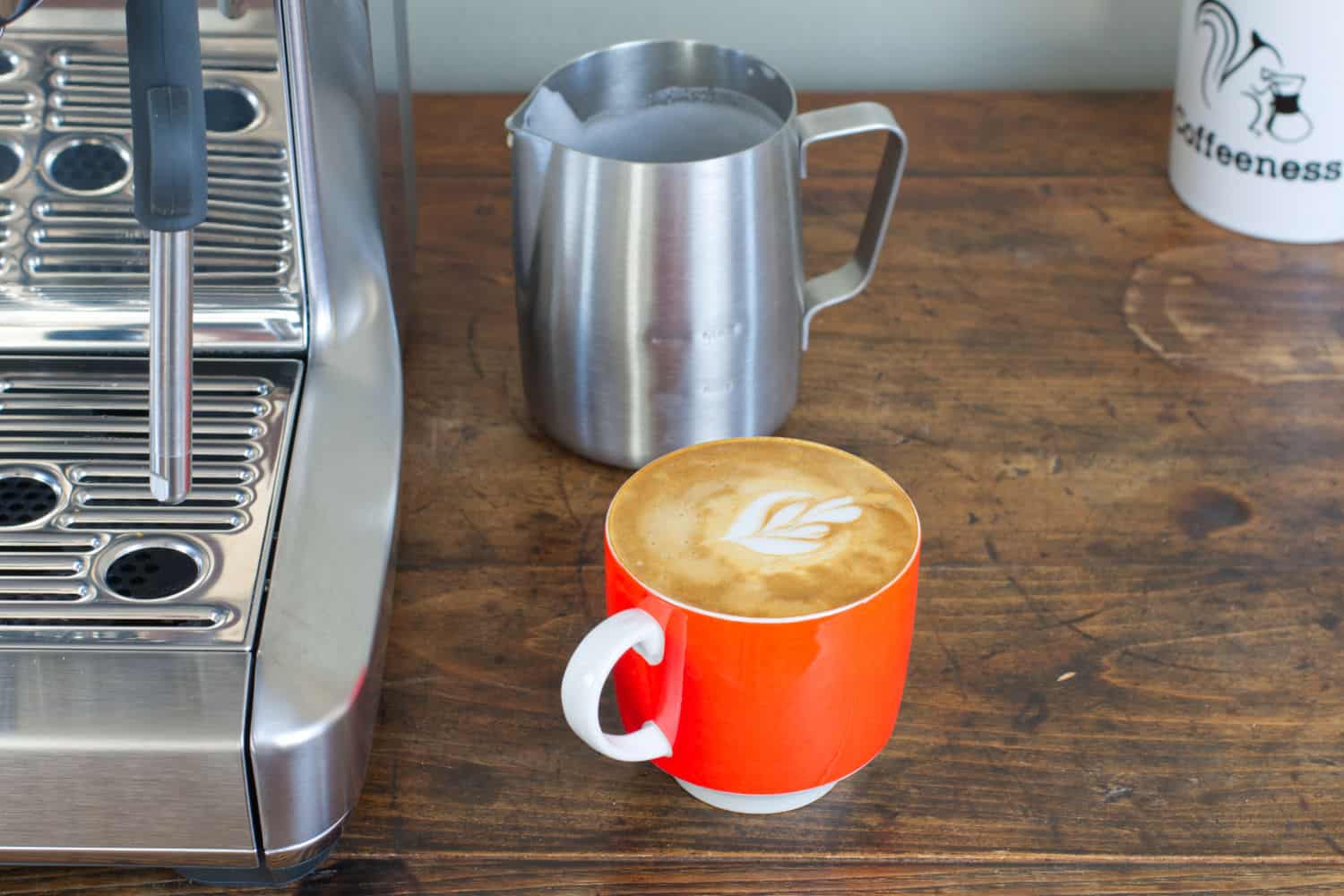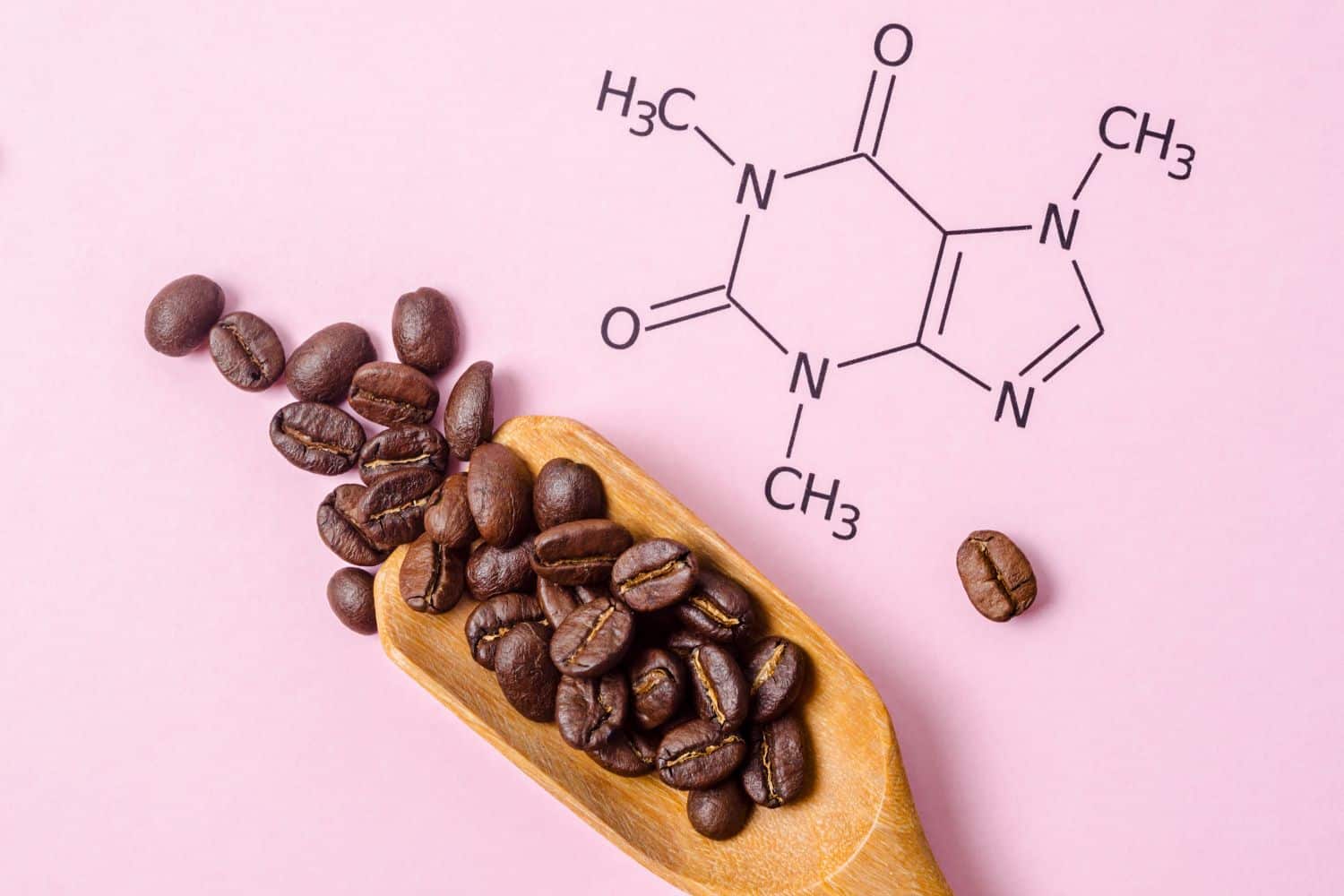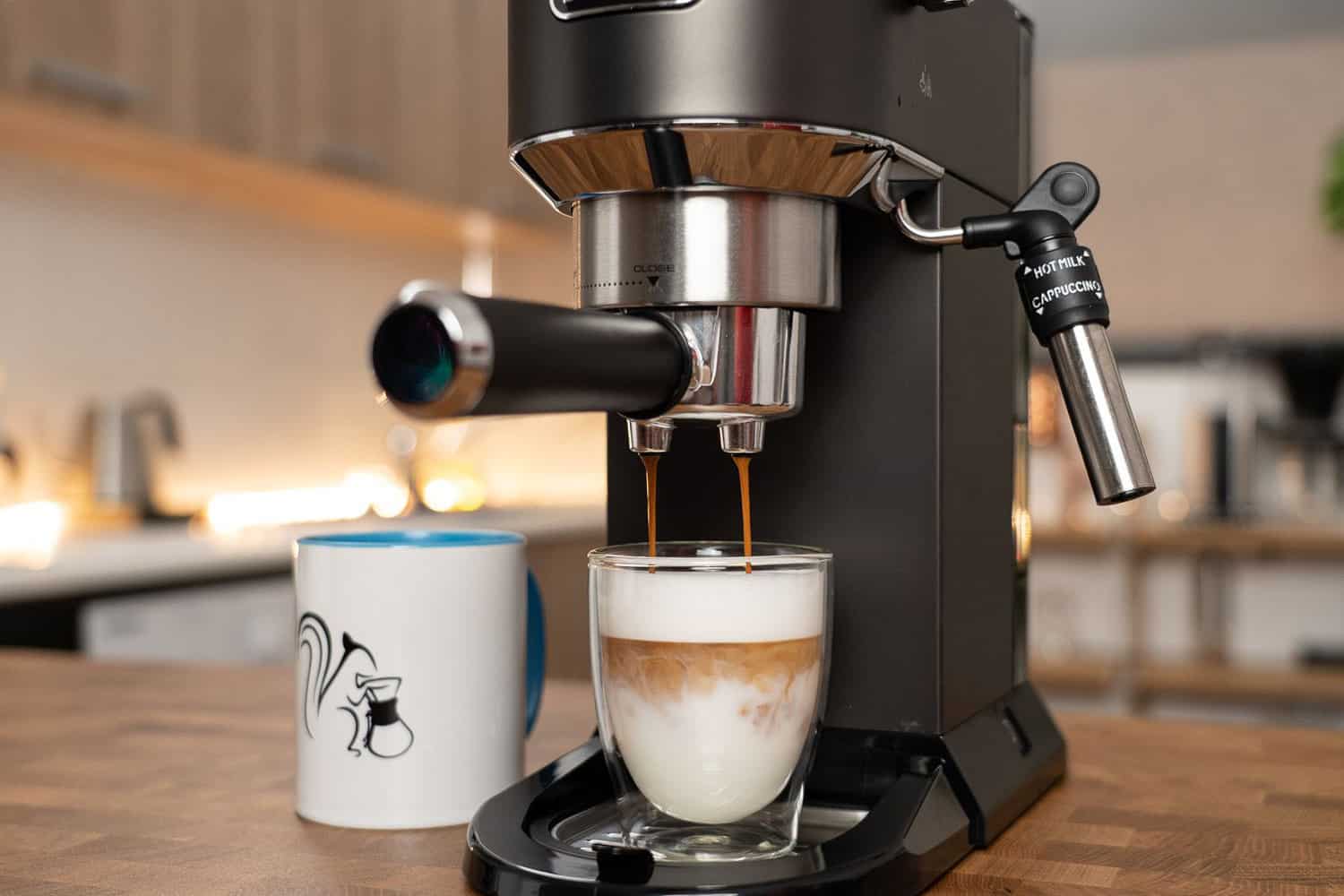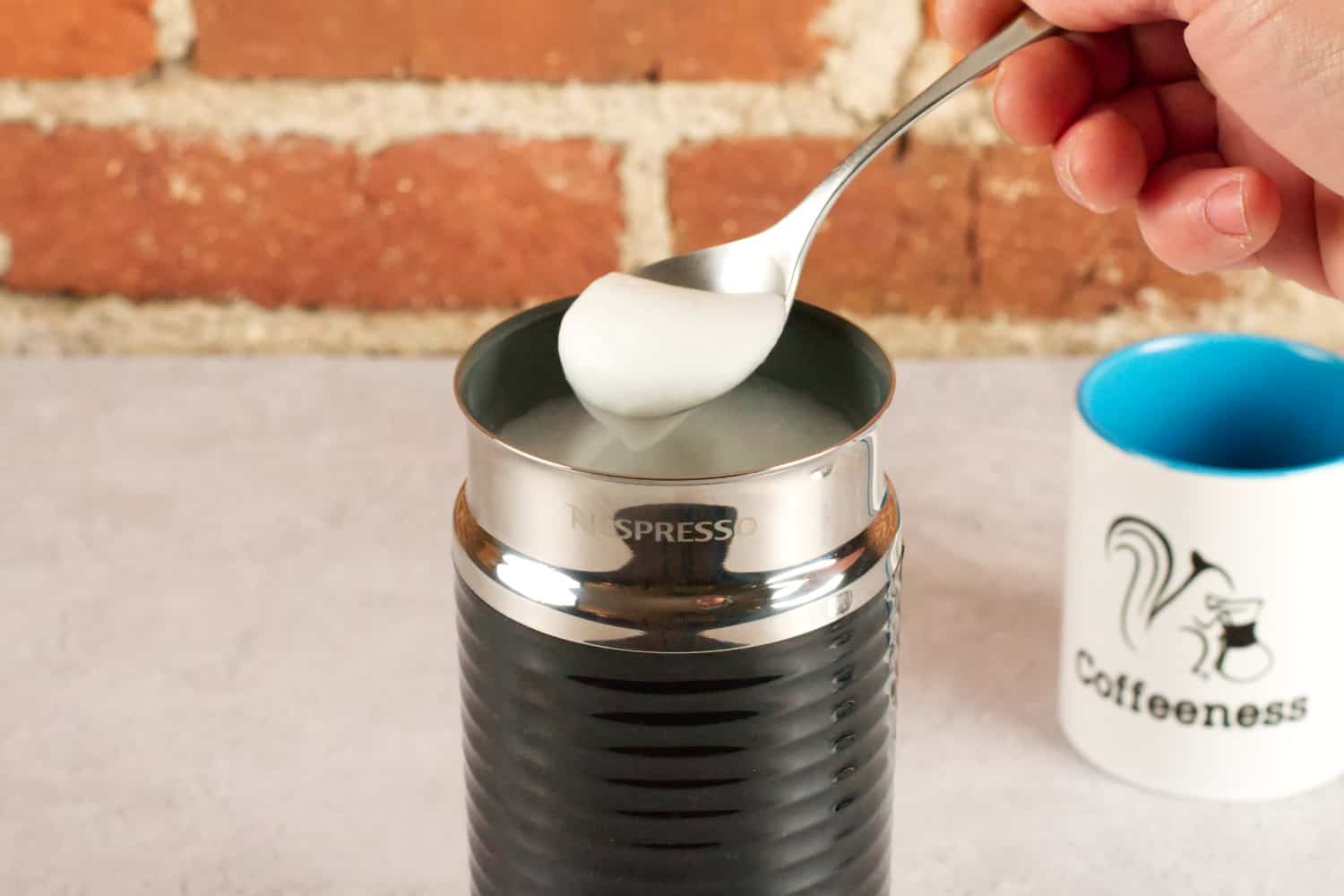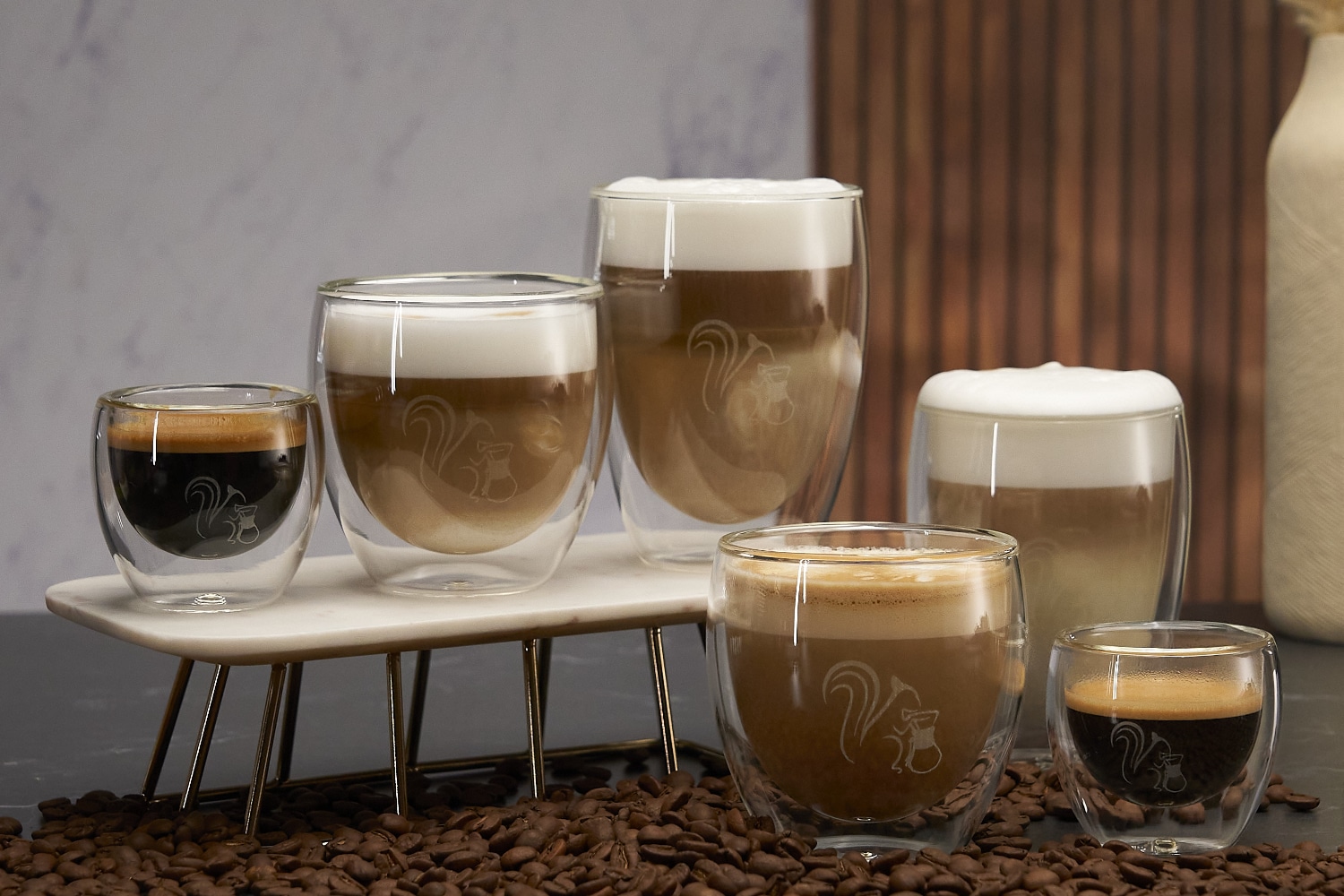There are two ideas in the coffee world about how to make latte macchiato. The purist camp wants to let the milk foam and espresso speak for themselves, with just a hint of sweetness from the milk. The sweet tooth camp wants to pile on the syrup and flavored drizzle.
While neither approach is wrong, there’s value in understanding the basics of how to make a latte macchiato. Then, you can make adaptations from there according to your palate and personal preferences.
Readers of my super automatic espresso machine guide often ask whether or not an espresso machine they’re interested in also scores well when it comes to making a decent latte macchiato.
I used to shy away from this question, but have been finding automatic espresso machines are more and more capable of delivering excellent latte macchiato. In fact, I even find myself pulling a tall glass off the shelf and preparing latte macchiato quite frequently, of late.
Of course, being that I belong to the purist camp, I only prepare mine with simple ingredients. After all, latte macchiato is one of the most enjoyable coffee recipes you can make with espresso and milk.
Table of Contents
What Is a Latte Macchiato?
They say when U.S. Secret service agents train to identify counterfeit money, they first study the real thing. By understanding the nature and look of genuine money, they quickly recognize what is not the true artifact.
Today, I’m going to apply the same logic to training you in how to make latte macchiato. My hope is that by teaching you the characteristics of this amazing coffee drink, you’ll have information you can take to the bank, so to speak.
Much like the French cliché of offering highly diluted wine to children, Italians consider latte macchiato a children’s drink. South of the Alps, no one cares when they see kids drinking coffee.
The telltale sign to look for is layering. A true latte macchiato should have noticeable layers of warm milk, followed by espresso and topped with milk foam. This signature look is created by slowly pouring the espresso into the steamed milk.
Getting the correct ratio of steamed milk, espresso and milk foam is paramount. A latte macchiato consists of one 0.8-ounce (25-milliliter) shot of espresso, 5-6.8 ounces (150-200 milliliters) of steamed milk, and 1-2 dollops of milk foam.
The steamed milk is poured into the glass first. It’s followed by adding the milk foam to the top. Then, you pour the shot of espresso through the layer of foamed milk down into the steamed milk. This is where we get the name latte macchiato, which means “stained milk.” The coffee essentially adds a stain to the milk foam when it’s poured in.
The triple layering in the glass is miles away from “grown-up” milk-based coffee specialties. In comparison:
Latte Macchiato has a 1:10 ratio of espresso to milk foam
Cappuccino has around a 1:5 ratio of espresso to steamed milk
Espresso Macchiato turns it around to a 5:1 ratio of espresso to milk foam
So, with a latte macchiato, milk is the defining feature.
Coffeeness Medium Roast Espresso
Well-balanced with chocolate & hazelnut notes
Freshly roasted in Brooklyn
Very low acidity
Latte Macchiato Layers: What’s the Point?
Believe it or not, the layers are more than just about making the drink look awesome!
Milk foam is largely made up of air. This creates a cushion that helps embed the espresso in the latte macchiato. When you stir, you’re bursting the air bubbles – and you might as well order yourself a latte (United States) or caffè latte (Italy), instead (double espresso, lots of milk, a touch of milk foam).
Even if layer upon layer is primarily a visual highlight, it certainly serves a purpose for a successful flavor.
With each unstirred sip (put down the straw!) you allow yourself a complex mouthfeel: strong espresso, creamy milk foam, warm milk. So if you want to stir something correctly, do it in your mouth, not in the glass with a spoon.
Latte Macchiato vs Latte: Is There a Difference?
There are essentially three primary differences between a latte macchiato and a latte (aka: caffè latte).
A latte macchiato is a shot of espresso poured into steamed milk and milk foam, whereas a latte is milk poured into one or two shots of espresso.
Latte macchiato will have defined layers, but a latte gets swirled around to evenly mix the steamed milk and espresso before any milk foam is added to the top.
Usually, only one shot of espresso goes into a latte macchiato, but a latte will often have two shots.
Variations do exist of course, but these three principles should remain the same.
Latte Macchiato vs Cappuccino: What’s the Difference?
The question of how a latte macchiato differs from a cappuccino speaks volumes about its interim decline.
First, there’s the ever-expanding size and all the flavor additions that both drinks regularly endure.
Next, it’s become increasingly hard to tell which specialty coffee beverage goes into a glass and which is better suited to a cup. Practically speaking, putting a latte macchiato in a cup wouldn’t make sense, as doing so would prevent people from seeing the layers.
Generally, both consist of a single shot of espresso and milk foam. Let’s look more closely:
You should divide a latte macchiato into three parts, consisting of layers of milk foam, warm milk and espresso. The overall volume should be around 10 ounces (300 milliliters).
On the other hand, a cappuccino requires more warm milk and only a small cap of foam. The overall volume should be around 6 ounces (180 milliliters).
However, we usually ignore the division. For a homemade latte macchiato recipe, it’s more practical to foam the milk completely, using the steam wand on an espresso machine or super automatic espresso machine.
Another common solution is to task an integrated milk foam system with dispensing the maximum amount of foam.
Apart from the difference in overall volume, a cappuccino is more coffee-focused than a latte macchiato. It highlights the respective style of espresso beans in a more concentrated way.
Light or Dark: Which Coffee Beans Work Best for Latte Macchiato?
Let’s assume that you drink latte macchiato because it just doesn’t taste that much like coffee. You still need a little more oomph to compete with all that milk.
Roasts for latte macchiato should be bolder and darker
You’re also able to bring a touch more bitterness into play. The frothed milk in the glass – with its caramelized sugar molecules – provides enough sweetness to balance out bitter notes.
In other words, you can use beans with either a dark or a light roast profile to make a latte macchiato, but the flavors will stand out more the darker you go.
Added bonus: If the roast is bolder and darker, you’ll use fewer coffee beans. Still, no matter which shade you choose to brew with, it remains important that you only buy from good roasters. They should do everything right in terms of transparency, fairness and the requirements for sustainable coffee and organic coffee.
Milk Plus Coffee: How Many Calories Are in a Latte Macchiato?
I find questions like this increasingly stupid. They imply that by counting calories and weighing ourselves, we are somehow “improving” our figure. Even though I’m a fitness freak myself, it’s not your daily latte macchiato making your pants feel tighter.
Rather, it’s all the additives, flavored syrups and toppings on offer at the biggest coffee companies. Let’s do a quick check:
A (homemade) latte macchiato that’s prepared with 6.8 ounces (200 milliliters) of pasture-raised milk (fat content 3.8 percent) contains about 130 calories.
If you replace the dairy with a popular non-dairy milk like almond or oat, we’re quickly down to around 46 and 96 calories per glass, respectively.
Now, if you run to Starbucks and order a Tall (12-ounce / 350-milliliter) caramel latte macchiato with whole milk, you’ll take in 210 calories – even though the same amount of cold milk and espresso was used. It’s all thanks to drizzle and syrup.
You can find the ingredients in a latte in the Starbucks Beverage Nutrition Information table. The calorie trap doesn’t come from the steam wand after all.
Wake-Up Call: How Much Caffeine Is in a Latte Macchiato?
While we’re doing math, we might as well clarify how much caffeine is in a latte macchiato. Of course, for this, we only need to inspect the coffee, which is usually only a single shot of espresso.
According to my caffeine study, a latte macchiato contains about 68 milligrams of caffeine. This value is a good benchmark if you’re concerned about drinking coffee during pregnancy.
Current medical recommendations state a maximum of 200 mg per day for healthy pregnant women. Anyone without a baby on board should stay below the recommended 400 mg per day maximum.
Still, in practical terms, that would be almost six latte macchiatos and thus almost 2.5 pints (1.2 liters) of milk. That’s when the discussion on calories would need to come into play.
How to Make Latte Macchiato: Top Tips for Each Method
If we look at the rule for latte proportions:
First part warm milk
Second part milk foam
Final part espresso poured on top
… and simply froth all the milk, we can make a latte macchiato with almost anything on the market. Except, of course, with a drip coffee maker. You could potentially make an approximation of a latte macchiato with a Ninja Specialty Coffee Maker, but that would mean using concentrated coffee and not true espresso.
How To Make Latte Macchiato With a Super Automatic Espresso Machine
In my article on the best super automatic espresso machines, I threw in some handy tips about how to make a latte macchiato. Here are a few highlights:
Jura machines make fantastic latte macchiatos.
If you’re learning how to make milk foam, remember to always use cold milk from the fridge.
Use darker fully automatic roasts and/or increase the amount of coffee per shot.
Some automatic espresso machines will allow you to pull a shot of espresso and steam milk simultaneously, while others will require you to do one first and then the other. If you aren’t sure about the capabilities of your particular machine, check to see if it’s one I’ve reviewed here. On the rare occasion that it is not, you’ll need to check your instruction manual.
If there’s a super automatic espresso machine that you’d like me to review, please note that in the comments anywhere on the Coffeeness website. In the meantime, you can also check out my reviews of the best latte machines you can use to help you make an incredibly rich latte macchiato.
How To Make Latte Macchiato With an Espresso Machine
In the past, I would only have used a steam wand and real espresso from an espresso machine to prepare a latte macchiato. However, the ever-improving technology in super automatic espresso machines is impressive.
Even so, the old school Italian favorite is still the best way to make excellent specialty coffee beverages, depending on your skill level. You can fine-tune the settings on your coffee grinder and have total influence over the quality of the milk foam.
As you may have guessed, you must build a latte macchiato – so first froth the milk, then prepare the espresso and add it.
With a cappuccino, it’s the other way around. That’s why you can extract the espresso directly into a cappuccino cup or glass. When you’re preparing a latte macchiato, though, I’d go for a shot glass.
Most home espresso machines don’t have enough room between the spout and the drip tray to fit a latte cup. Plus, you’ll do yourself several favors by brewing separately:
If you first pour the foamed milk into the glass using a gentle circular motion, then allow it to stand for a short time, the foam structure will “solidify” significantly because of the fats in the milk.
As a result, the layers hold better and the latte macchiato ends up looking like it was built on a drawing board.
You can also help this more compact foam by swirling the jug again after steaming. This creates a more homogeneous consistency, even before it goes into the glass. Note: you don’t want to swirl the milk after the espresso is added in.
The “recipe” for the espresso is clear: water is forced through around 7 grams of finely ground, fresh espresso beans under a minimum of 9 bars of pressure. The extraction time should be around 25 seconds and the resulting espresso should clock in with a volume of 0.7-0.8 ounces (20-25 milliliters).
Immediately after pulling a shot of espresso, pour it with a fluid motion into the milk, as centrally as possible. Then serve the latte macchiato immediately.
How To Make a Latte Macchiato At Home: DIY Italian Style
The usual strict coffee standards don’t really apply when it comes to preparing a latte macchiato. So, there’s nothing to stop you from using a moka pot and a milk frother for your homemade latte.
In fact, this brings us closer to Italian “reality.” A Bialetti and a milk frother are much more likely to be in a Roman kitchen than an Italian espresso machine.
There are plenty of good devices for making fantastic milk foam in my milk frother guide. Be sure to check it out if you need recommendations that will work for various milk based coffee drinks, including latte macchiatos, cortados and cappuccinos.
When you’re brewing with a moka pot, you should be careful not to produce coffee that’s too strong and bitter. Over-extraction can happen quickly with this preparation method, so you’ll need your wits about you.
It’s worth using somewhat lighter roasts that have a lot of sweetness on board, especially when you’re first getting started. I’ve had great results using high-quality, single-origin coffees from Brazil.
Latte Macchiato Glasses: What To Look For
The Ikea glass used to be my standard measure for a latte macchiato fill. That is, until I decided to develop my own line of Coffeeness double-walled latte glasses. However, we still have a right to ask why we shouldn’t use a glass with a handle. Right?
I say: this coffee beverage is mostly about looks.
Double Walled Thermo Coffee Glasses
Enjoy your coffee drink hot for longer
Keeps your coffee warm longer
Made of robust borosilicate glass
Double-walled glasses solve the problem of burning your fingers as you’re going for the first sip. However, with super automatic espresso machines in particular, you have to pay attention to the maximum cup height of each model.
How To Make Latte Macchiato? With New-Found Confidence and Plenty of Milk!
Don’t let anyone from either the purist or sweet tooth schools of thought tell you that your way of making a latte macchiato is wrong. Ever since we started checking how automatic coffee machines handle layering, I’ve been enjoying it a lot more, too.
Lots of creamy milk, a strong coffee kick – what’s not to like?
Do you have any tips of your own for making the perfect latte macchiato? I look forward to reading your comments!
